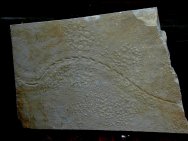Protichnites eremita
(Hagadorn and Seilacher, 2009)
Trace Fossil (Ichnofossil) - Arthropod Trackway
In association with sand stromatolites (a Cambrian microbial mat)
Geologic Time: Upper Cambrian (about 510 million years ago)
Size: (25.4 mm = 1 inch): Matrix is 24 by 19 inches and 2 inches thick
Fossil Site: Krukowski Quarry, Elk Mound Group, Mount Simon Sandstone, near Mosinee, Wisconsin
Fossil Code: DD702
Price: Sold
|
This particular specimen is the most recent Protichnites species first described in April 2009. Hagadorn and Seilacher hypothsize that the Protichnites eremita shown here was formed by so called hermite arthropods walked the Cambrian shore partially inside shells of other animals. This hermite crab-like strategy might have afforded the protection of a humid chamber that mitigated dessication of gills in the alien subaerial environment. The defining characteristic of Protichnites eremita is tail impressions that are angled to the left side of the track, as would be formed by a coiled shell intermittently scraping the sediment substrate. The presence of abundant sand stromatolites both above and below the tracks suggest that cyanobacterial mats mediated the preservation of Protichnites eremita. To our knowledge, this is the only Protichnites eremita to be made commercially available. We've held it for three years pending the publication below. Also visit the Cambrian Shadows Theme Park. Reference: Hagadorn, J. W., and Seilacher, A., Hermits 500 million years ago?: Geology 37(4), 295-298 (2009). |










